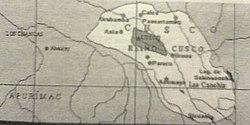Kingdom of Cusco: Difference between revisions
m robot Adding: es:Curacazgo Inca |
|||
| Line 51: | Line 51: | ||
In 1438 AD, under the command of [[Sapa Inca]] (paramount leader) [[Pachacutec]], whose name literally meant "world-shaker", they began a far-reaching expansion. The land Pachacutec conquered was about the size of the [[Thirteen Colonies]] of the [[United States]] in 1776, and consisted of nearly the entire [[Andes]] mountain range. |
In 1438 AD, under the command of [[Sapa Inca]] (paramount leader) [[Pachacutec]], whose name literally meant "world-shaker", they began a far-reaching expansion. The land Pachacutec conquered was about the size of the [[Thirteen Colonies]] of the [[United States]] in 1776, and consisted of nearly the entire [[Andes]] mountain range. |
||
[[Image:Late-intermediate-peru.png|thumb|left|The Kigdom of Cusco in 1438, shown in red on the map.]] |
[[Image:Late-intermediate-peru.png|thumb|left|The Kigdom of Cusco in 1438, shown in red on the map.]] |
||
Pachacutec reorganized the kingdom of Cuzco into an empire, the Tahuantinsuyu, a [[federation|federalist system]] which consisted of a central government with the Inca at its head and four provincial governments with strong leaders: [[Chinchasuyu]] (NW), [[Antisuyu]] (NE), [[Contisuyu]] (SW), and [[Collasuyu]] (SE). Pachacuti is also thought to have built [[Machu Picchu]], either as a family home or as a |
Pachacutec reorganized the kingdom of Cuzco into an empire, the Tahuantinsuyu, a [[federation|federalist system]] which consisted of a central government with the Inca at its head and four provincial governments with strong leaders: [[Chinchasuyu]] (NW), [[Antisuyu]] (NE), [[Contisuyu]] (SW), and [[Collasuyu]] (SE). Pachacuti is also thought to have built [[Machu Picchu]], either as a family home or as a vacational retreat. |
||
==Sapa Incas== |
==Sapa Incas== |
||
Revision as of 18:29, 8 September 2008
This article has no lead section. |
Kingdom of Cusco Curacazgo Inca | |||||||
|---|---|---|---|---|---|---|---|
| 1197–1438 | |||||||
 Map of the Kigdom of Cusco. | |||||||
| Capital | Cusco (1197-1438) | ||||||
| Common languages | Quechua, Puquina. | ||||||
| Religion | Inca religion | ||||||
| Government | Monarchy | ||||||
| Sapa Inca | |||||||
• 1200-1230 | Manco Capac | ||||||
• 1230-1260 | Sinchi Roca | ||||||
• 1260-1290 | Lloque Yupanqui | ||||||
• 1290-1320 | Mayta Capac | ||||||
• 1320-1350 | Capac Yupanqui | ||||||
• 1350-1380 | Inca Roca | ||||||
• 1380-1410 | Yahuar Huacac | ||||||
• 1410-1438 | Viracocha (Inca) | ||||||
| Historical era | Pre-Columbian | ||||||
• Manco Capac organized the Kingdom of Cusco | 1197 | ||||||
• Pachacutec created the Tawantinsuyu | 1438 | ||||||
| Area | |||||||
| 40,000 km2 (15,000 sq mi) | |||||||
| |||||||
History
The Inca people began as a tribe in the Cuzco area around the 12th century AD. Under the leadership of Manco Capac, they formed the small city-state of Cuzco (Quechua Qosqo), shown in red on the map.
In 1438 AD, under the command of Sapa Inca (paramount leader) Pachacutec, whose name literally meant "world-shaker", they began a far-reaching expansion. The land Pachacutec conquered was about the size of the Thirteen Colonies of the United States in 1776, and consisted of nearly the entire Andes mountain range.

Pachacutec reorganized the kingdom of Cuzco into an empire, the Tahuantinsuyu, a federalist system which consisted of a central government with the Inca at its head and four provincial governments with strong leaders: Chinchasuyu (NW), Antisuyu (NE), Contisuyu (SW), and Collasuyu (SE). Pachacuti is also thought to have built Machu Picchu, either as a family home or as a vacational retreat.
Sapa Incas
First dynasty
The Sapa Inca of the first dynasty of the Kingdom of Cuzco were, in order, Manco Capac, Sinchi Roca, Lloque Yupanqui, Mayta Capac, and Capac Yupanqui. Little is known of these early rulers, but as a rough guide, in later years capac meant warlord and sinchi meant leader. The beginning of the dynasty is generally taken as about 1200 CE.
Second dynasty
The Sapa Inca of the second dynasty of the Kingdom of Cuzco were, in order, Inca Roca, Yahuar Huacac, Viracocha, and Pachacuti (considered also the first Sapa Inca of the Tawantinsuyu). The second dynasty marked the transition in dominance from the hurin to hanan family.
Notes
Bibliography
- Template:Es icon María Rostworowski. Enciclopedia Temática del Perú: Incas. Lima: El Comercio S.A., 2004.
- Template:Es icon Editorial Sol 90. Historia Universal 5: América precolombina. Barcelona, España, 2002.
- Template:En icon Bushnell. Peru, Ancient people and places.
- Template:En icon MacQuarrie, Kim. The Last Days of the Incas. Simon & Schuster, 2007. ISBN 978-0743260497.
